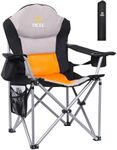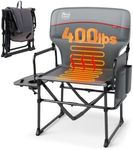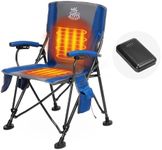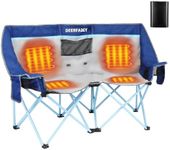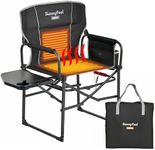Buying Guide for the Best Heated Outdoor Chair
Choosing a heated outdoor chair can make your time outside much more comfortable, especially during chilly evenings or colder seasons. The right chair will keep you warm, support your body, and withstand outdoor conditions. When shopping, it's important to consider how and where you'll use the chair—whether it's for camping, backyard gatherings, or sporting events. Think about how portable you need it to be, how long you want the heat to last, and what kind of weather it needs to handle. Understanding the key features will help you find a chair that fits your lifestyle and keeps you cozy outdoors.Heating MethodThe heating method refers to how the chair generates warmth, usually through built-in electric heating pads powered by batteries or sometimes by plugging into a power source. This is important because it affects how quickly and evenly the chair heats up, as well as how safe and convenient it is to use. Some chairs offer multiple heat settings, while others have a single temperature. If you want more control over your comfort, look for adjustable heat levels. If you prefer simplicity, a single setting might be enough. Consider your typical outdoor temperatures and how much warmth you usually need.
Power Source and Battery LifeMost heated outdoor chairs use rechargeable batteries, but some may require disposable batteries or a direct power connection. Battery life determines how long the chair can keep you warm before needing a recharge or new batteries. This is crucial if you plan to use the chair for extended periods, like during long events or camping trips. Shorter battery life (1-2 hours) is fine for quick outings, while longer battery life (4-8 hours or more) is better for all-day use. Think about how long you typically sit outside and whether you'll have access to charging options.
Weather ResistanceWeather resistance means how well the chair can handle outdoor conditions like rain, snow, or sun. This is important because outdoor chairs are exposed to the elements, and you want your investment to last. Some chairs are water-resistant or waterproof, while others are only suitable for dry conditions. If you expect to use the chair in unpredictable weather, look for materials and construction that can handle moisture and UV rays. If you'll mostly use it under cover or in fair weather, this may be less critical.
Portability and WeightPortability refers to how easy it is to carry and move the chair, which is influenced by its weight and whether it folds up. This matters if you plan to take the chair to different locations, like campsites, parks, or sporting events. Lightweight and foldable chairs are easier to transport, while heavier, bulkier models may be more comfortable but harder to move. Consider how far you'll need to carry the chair and whether you'll be packing it in a car or carrying it by hand.
Comfort and SupportComfort and support are about how the chair feels when you sit in it, including the padding, backrest, and seat size. This is important for enjoying long periods outdoors without discomfort. Some chairs have extra cushioning, lumbar support, or wider seats. If you plan to sit for hours, look for features that match your body type and comfort preferences. If you only need the chair for short breaks, basic support may be enough.
Ease of CleaningEase of cleaning refers to how simple it is to keep the chair looking and smelling fresh after use. Outdoor chairs can get dirty from mud, food, or spills, so materials that wipe clean or have removable, washable covers are helpful. If you expect to use the chair in messy environments or with kids and pets, prioritize easy-to-clean options. If you'll use it in cleaner settings, this may be less of a concern.


